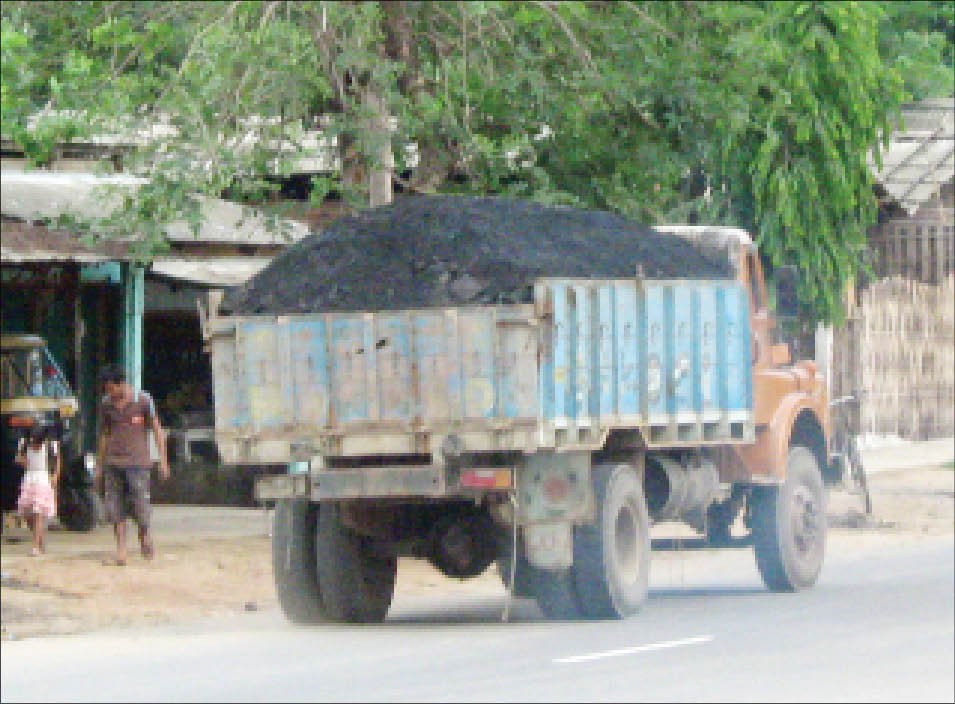A coal-laden truck coming from towards Niuland and bound for Dimapur. With no worthwhile industry, most of the coal mined in Nagaland is used in small-scale businesses such as blacksmithy. (Morung Photo)

Imkong Walling
Dimapur | June 24
The overtly hyped and highly anticipated ‘heavy-oil based thermal power plant’ at 7th Mile, Dimapur has reached a dead end. Not being “cost effective” was the rationale put forth for its abandonment. The justification holds ground considering the state does not have the sufficient raw material (petroleum) to feed the proposed plant. Petroleum-based heavy oils such as diesel is required in an ‘oil-based’ thermal plant to generate electricity, of which it is inferred the state does not have potential long-term reserves. To sustain such a plant, a guaranteed and long term supply of fuel oil is a must. Experts say that Nagaland fails in this aspect implying the state would have had to import it from outside the state at high costs, if it did became operational. Experts are of the opinion that the import and transportation costs will be very high, impacting its economic viability. Furthermore, power generated from such a plant will be very expensive which ultimately would affect the consumers.
There is no denying the potentialities of hydro based projects. However, “contrary to popular notion the state has very limited water resources for power generation” stated a concept note on ‘Nagaland Power sector Reforms & Restructuring the Joint Venture Route’. The state at present has four potential hydro based projects namely — Tizu-Zungki (150 MW), Dikhu (120 MW), Yangyu (40 MW) and Doyang stage III (24 MW) reported as being under various stages of planning. “If these projects”, the concept note stated, “are taken up in similar pattern as Doyang Hydro Electric Project (DHEP), the peak demand of the state from the present 80 megawatts can never be met.” It is projected that the peak demand for power in the state will reach 200 megawatts by the year 2012.
Such a proposition the note assessed will make no significant impact on the current power scenario of the state “neither will it bring any additional revenue to the state government”. Even if all the projects are executed under same pattern as DHEP, the state will get a maximum of 60 megawatts during the peak season and a minimum of 15 megawatts during the lean season, “whereas” the note cautioned “all the available water resources would be exploited” by then.
At such a juncture a coal based thermal plant for the immediate future is of utmost necessity and very feasible. The state, if experts in the field are to go by, has in abundance rich reserves of high grade coal. Expert members associated with Nagaland Geoscientist Association (NGA) states that Nagaland has “inferred” and potential coal reserves estimated at about 315 million tonnes. Unfortunately these are being exploited with no significant contribution to the state laments Mar Imchen former literary secretary of NGA. He states that if these reserves are harnessed in a scientific manner prospects of setting up of thermal plants fired on coal is very positive.
He banks on the “high calorific” output of coal found in the state with low ash residue. The only hitch being its high sulphur content. This he said can be taken care of by a process called “desulphurization” in scientific terminology. However, this is a very costly procedure hence not cost effective, suitable only for large sized plants. Instead he says we can opt for small sized plants with output of about 25-30 megawatts wherein the said process will not be required. According to studies Mon, Mokokchung, Longleng, Wokha and Tuensang have rich reserves of coal while Niuland area in Dimapur district is also assessed as having promising reserves. Setting up a chain of 25-30 megawatts output plants along these coal bearing belts of the state is very promising it is assessed. Because of the high calorific output of coal found in the state it is estimated only about 1.5 lac tonnes of coal per year will be required to feed one 25-30 megawatts thermal plant.
“And this is to be maintained for at least 25 years to make the project viable” and profitable notes a ‘Report on Coal Supply Agreement meeting with Coal-Miners of Nagaland’ held in the month May. In the report the state Directorate of Geology & Mining indicates that coal mining is done by coal owners in their own ways without consulting the department.
However, this can be regulated with the ‘Coal Mining Rule 2006’ (which requires “Prospecting Licence followed by Mining Lease, Mine plan approval and Mine Closure Plans etc”) having been formulated paving the way for an uninterrupted, sustainable and long term supply of raw materials. A plant site can be located at an “optimum place” the report states having proper road connectivity.


.jpg)



